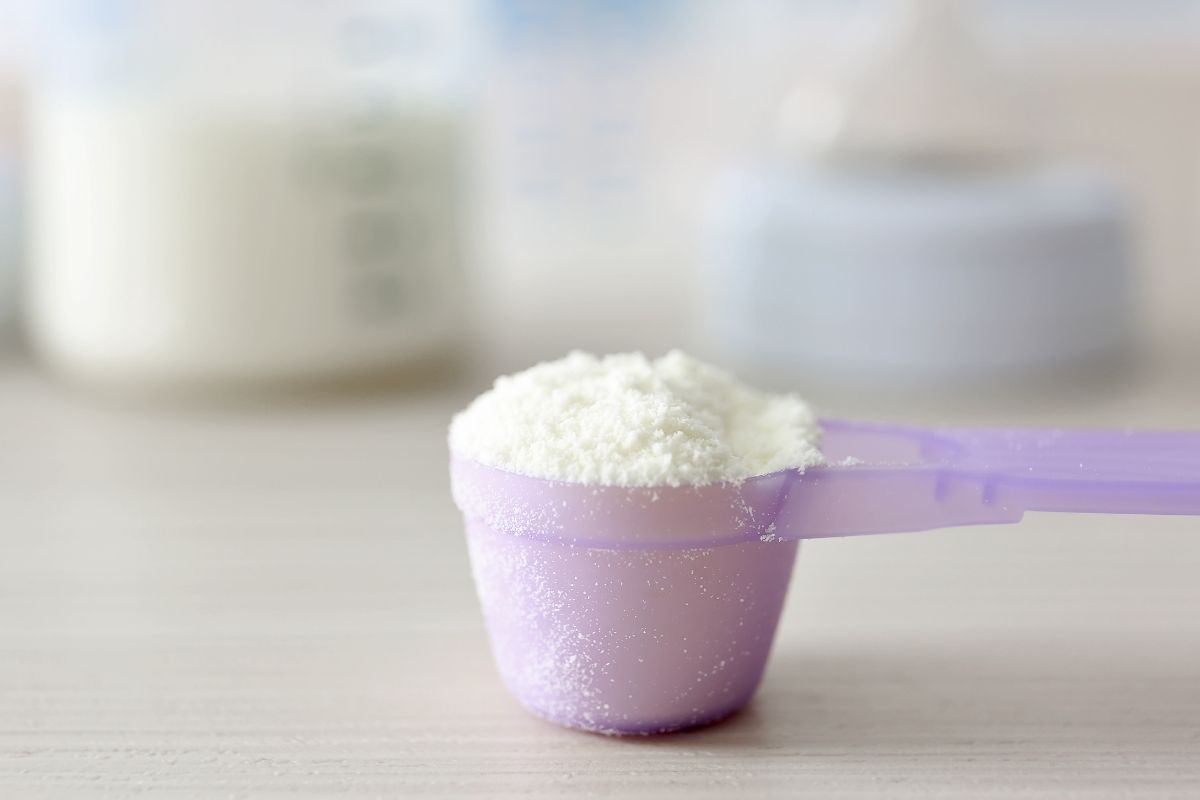
Amidst the swirling whirlwind of ‘breast is best’ messages, let’s pause for a moment and focus on the many moms who find themselves straddling the worlds of breastfeeding and formula feeding. We see you, we understand you, and this article is for you.
Motherhood is a journey filled with intricate decisions and unexpected twists, and the path of nourishing your little one can be just as complex. While the benefits of breast milk are undeniable, life’s circumstances sometimes lead us down a different road.
Today, we want to acknowledge the challenges you face the choices you’ve made, and provide a thoughtful guide for navigating the delicate terrain of supplementing with formula. So, whether you’ve just embarked on this unique blend of feeding or you’re considering this route, join us as we delve into the intricate world of supplementing breast milk with formula!
Table of content
- Understanding Supplementing: The ‘Why’
- When Breastfeeding Meets Baby Formula: The Science Bit
- Navigating the Supplementing Route: The ‘How’
- Safeguarding Breast Milk Supply While Bottle Feeding
- The Emotional Side of Supplementing
- Tools for Success: Supplementing Essentials
- Healthcare Professionals: Your Ally in This Journey
- Concluding Remarks
Understanding Supplementing: The ‘Why’
Using formula for supplementing breast milk stems from the complexity of motherhood beyond one-size-fits-all ideals. It’s a decision that can be complex and influenced by many factors that center around the well-being of both a mama and her precious baby. Some of the reasons include:
1) Low Breast Milk Supply
One of the most common challenges that necessitates the introduction of formula is a low enough breast milk supply. Factors such as very low birth weight (LBW) infants, preterm births, and other medical conditions can affect a baby’s ability to feed and can, in turn, impact the mom’s milk production.
2) Health Conditions
Additionally, a mom’s own health conditions can also affect breastfeeding. Needing to take certain medications or medical treatments might lead a mom to consider supplementing as a way to meet her little one’s nutritional needs while also taking care of her own health.
3) Lifestyle
The decision to supplement breast milk can also be influenced by lifestyle factors. Modern life’s demands, like work, impact breastfeeding consistency. Supplementing aids moms who seek balance amid work, family, and self-care demands, offering flexibility for these dynamics.
4) Personal Choices
Moreover, personal choice also plays a crucial role. The ability to feed one’s child is deeply intertwined with a mom’s autonomy, and there are instances where a mom may decide to supplement based on her own preferences and beliefs.
When Breastfeeding Meets Baby Formula: The Science Bit
So, how do the two feeding options compare in supplying macronutrients? The composition of human breast milk is a marvel in itself, an intricate blend of water, carbohydrates, protein, and fat, each element playing a vital role in nourishing your little one’s development. Many babies are still able to get these elements through traditional infant formula, namely cow’s milk-based formula.
1) Carbohydrates: Fueling Growth and Gastrointestinal Flourish
Comprising around 7% of breast milk, carbohydrates fuel your baby’s rapidly developing body. The principal carbohydrate found in breast milk is lactose. Collectively, carbohydrates also lay the foundation for a healthy gastrointestinal tract and contribute to the composition of the gut microbiota.
2) Protein: The Architects of Growth and Function
Making up about 1%, protein is a dynamic force behind the formation and organization of cells, ensuring proper growth, development, and physiological function in your baby. The protein content in breast milk includes a mixture of whey and casein, along with various peptides needed for nourishment.
3) Fat: Powering Development and Nervous System
Accounting for nearly half of the total energy content in breast milk, fat is more than just a calorie source; it’s a fundamental contributor to your baby’s development and the maturation of the central nervous system. As your breastfeeding journey progresses, the fat content in breast milk evolves, from the initial colostrum that contains around 15-20 g/L of fat to mature milk containing almost 40 g/L.
Curious about the macronutrients in your baby’s formula and how they impact growth and development? Uncover the facts in our in-depth article, ‘Baby Formula Ingredients Guide: What do They Mean?‘ Click to explore the nutritional science behind baby formula.
Navigating the Supplementing Route: The ‘How’
Next, we’ve compiled a step-by-step guide to help you navigate the process of introducing formula to breastfed babies, ensuring a seamless integration that honours both your baby’s needs and your unique breastfeeding journey.
1) Creating a Comfortable Feeding Environment
Begin by creating a calm and comfortable space for feeding. Hold your baby in an upright position, allowing for close contact and a sense of security.
2) Gentle Bottle Introduction
To ease your baby into bottle feeding, take a gentle approach. Touch your baby’s bottom lip with the bottle nipple, encouraging them to open their mouth naturally. Slowly and gently place the nipple inside their mouth, avoiding any force that might cause discomfort.
3) Start with Small Amounts
Start by offering only 1/2 to 1 ounce of formula in the bottle. This smaller quantity allows your baby to adjust to the new feeding method without feeling overly full. Observe your baby’s cues and response to the formula feeding, and increase the amount gradually if they show signs of hunger and interest.
4) Timing and Frequency
Introduce the bottle once a day between breastfeeding sessions when your baby is neither overly full nor excessively hungry. This strategic timing reduces stress and allows your baby to explore this new feeding method at their own pace. Unsure about how much formula your baby needs or how often to feed them? Take the guesswork out of feeding with our comprehensive ‘Baby Formula Feeding Chart: How Much and How Often Babies Eat.’
5) Switch Positions
Around halfway through the bottle-feeding, consider switching your baby’s position from one arm to the other. This mimics the natural variation in breastfeeding positions and helps prevent a preference for one side when breastfeeding.
6) Allow Natural Rhythms
Just like during breastfeeding, let your baby take breaks as needed to control the flow of formula, and never force your baby to finish the milk in the bottle. Pay close attention to their signs of readiness to stop feeding.
Safeguarding Breast Milk Supply While Bottle Feeding
An essential aspect to consider as you introduce formula is maintaining your breast milk supply as a priority. Not only does breast milk continue to offer unique health benefits to your baby, but a steady milk supply can also grant you the flexibility to transition between breast milk and formula seamlessly.
Here are some practical tips that can help you balance both feeding options:
- Pump Regularly: Incorporating a pumping schedule into your routine can stimulate your breasts to produce more milk. Pumping sessions can complement your baby’s feeding times, and even if you’re offering formula, these sessions help signal to your body the demand for milk.
- Skin-to-Skin Contact: Skin-to-skin contact with your baby not only strengthens your bond but also encourages milk production. The warmth and closeness trigger hormonal responses that support enough milk supply.
- Breastfeed on Demand: Whenever possible, breastfeed your baby on demand. The frequent emptying of your breasts, as guided by your baby’s cues, tells your body to produce more milk to meet the demand.
- Stay Hydrated: Hydration is a cornerstone of milk production. Aim to drink plenty of water throughout the day. Keeping yourself well-hydrated helps your body generate an ample milk supply.
- Nourish Yourself: A balanced diet rich in nutrients supports your overall well-being and milk production. Including foods known to enhance milk supply, such as oats, leafy greens, and lean proteins, can positively impact your lactation journey.
- Mind Your Stress: Stress can impact milk production. Engaging in relaxation techniques, finding moments of calm, and seeking support from loved ones can help manage stress levels and contribute to a healthier milk supply.
The Emotional Side of Supplementing
Embarking on the journey of supplementing breast milk with formula can evoke a complex mix of emotions. However, it’s important to remember that you’re not alone! Countless mothers around the world have grappled with similar feelings of guilt, uncertainty, and the desire to provide the best for their precious ones.
Feelings of guilt can stem from societal expectations, well-meaning advice, and internalized ideals of what motherhood should look like. Similarly, uncertainty can arise from the unknown territory of mixing breastfeeding and formula feeding, the fear of judgment, and the concern for your baby’s well-being. These emotions are normal reactions to a complex decision, and recognizing them is the first step toward addressing them.
By reaching out to supportive communities, engaging in open conversations, and seeking guidance from those who understand, you can find solace and solidarity. Online forums, support groups, and conversations with healthcare providers can provide a space where you can share your feelings without judgment and receive the understanding you deserve.
Tools for Success: Supplementing Essentials
To ensure a seamless process of combining both feeding methods, it is important to invest in the right tools that will save you time and energy while providing your baby with the needed nutrition. So, here is what you’ll need:
- A quality breast pump stands at the forefront. Choose a pump that suits your lifestyle, whether it’s a manual or electric variant, and explore features like adjustable settings for personalized comfort.
- Bottles designed to mimic the natural breastfeeding experience can foster a smoother transition for your baby between breast and bottle. Select bottles that reduce air intake and promote proper latch, providing a seamless flow of both pumped breast milk and formula.
- Lastly, your toolkit wouldn’t be complete without a reliable, high-quality formula that aligns with your baby’s nutritional needs. Consulting with healthcare professionals can guide you in choosing the formula that complements your breast milk and caters to your baby’s specific requirements.
Just as important when supplementing breast milk with formula is a stringent hygiene checklist that ensures your baby’s well-being and safety. As such, make sure to:
• Wash your hands thoroughly before handling bottles, formula, or feeding equipment.
• Sterilize and regularly clean tools like formula bottles, nipples, and pump parts.
• Follow the manufacturer’s instructions when preparing the formula, ensuring the right consistency.
• Promptly feed prepared formula or store as guided in the refrigerator.
• Regularly inspect and replace feeding equipment to uphold quality and safety.
Healthcare Professionals: Your Ally in This Journey
When navigating the path of supplementing breast milk with formula, seeking guidance from healthcare professionals becomes an invaluable compass. Discussing your supplementing plan with a knowledgeable lactation consultant and your baby’s doctor can provide a wealth of insights, advice, and reassurance. Their support goes beyond clinical advice; it serves as a source of encouragement, enabling you to make informed decisions with confidence and ensuring the well-being of both you and your little one.
Concluding Remarks
Motherhood is a path that traverses diverse terrains, and what matters most is the health, happiness, and well-being of both the mom and her baby. Supplementing isn’t a deviation from an ideal; it’s a testament to a mom’s adaptability, love, and dedication to nurturing her child in the most suitable way possible.
Every feeding choice you make, whether it involves breast milk, powder baby formula, or a combination of both, is a reflection of your devotion as a parent. As you prioritize your baby’s well-being and navigate the emotional landscape, remember that your choices are equally honorable and worthy of celebration.
Frequently asked questions
Related articles

- /
Changes in Your Baby’s Poop After Starting Solids

- /
Baby Acne: Breast Milk as a Potential Cure

- /








